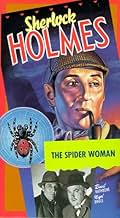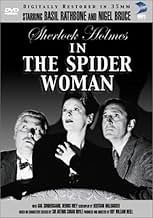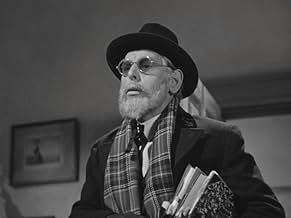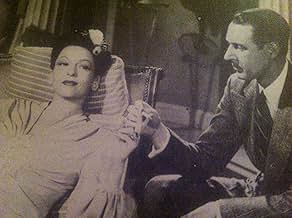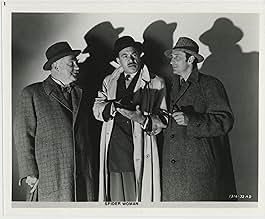CALIFICACIÓN DE IMDb
7.0/10
5.5 k
TU CALIFICACIÓN
Agrega una trama en tu idiomaSherlock Holmes investigates a series of so-called "pajama suicides". He knows the female villain behind them is as cunning as Moriarty and as venomous as a spider.Sherlock Holmes investigates a series of so-called "pajama suicides". He knows the female villain behind them is as cunning as Moriarty and as venomous as a spider.Sherlock Holmes investigates a series of so-called "pajama suicides". He knows the female villain behind them is as cunning as Moriarty and as venomous as a spider.
- Dirección
- Guionistas
- Elenco
Jimmy Aubrey
- News Vendor
- (sin créditos)
Mary Bayless
- Carnival Patron
- (sin créditos)
Brandon Beach
- Carnival Patron
- (sin créditos)
Frank Benson
- Toy Doll Attendant
- (sin créditos)
Lydia Bilbrook
- Susan
- (sin créditos)
John Burton
- Radio Announcer
- (sin créditos)
James Carlisle
- Casino Patron
- (sin créditos)
Harry Cording
- Fred Garvin
- (sin créditos)
Jack Deery
- Casino Patron
- (sin créditos)
Herschel Graham
- Casino Patron
- (sin créditos)
- Dirección
- Guionistas
- Todo el elenco y el equipo
- Producción, taquilla y más en IMDbPro
Opiniones destacadas
One of the best in Universal's Sherlock Holmes series, The Spider Woman dispenses, for the most part, with the overt WWII subject matter (which was also reasonably sparse in the previous outing, Sherlock Holmes Faces Death). The climax does make use of the image of Hitler and other Axis figures, but this was (aside from a brief mention in Dressed to Kill) the final direct war reference in the series. This bears mentioning because the film benefits strongly from the general lack of wartime subterfuge. Rather than battling Nazi agents, Rathbone's Sherlock is embroiled in a truly Holmesian mystery, surrounding several apparent suicides...which Holmes, naturally (and correctly), deduces to be homicides.
Though the opening credits proclaim "Based on a Story by Arthur Conan Doyle," The Spider Woman adapts (quite freely) major incidents from no less than five of Conan Doyle's tales...The Sign of Four, The Speckled Band, The Final Problem, The Empty House (also referenced in Sherlock Holmes and the Secret Weapon), and The Devil's Foot. False advertising, maybe...but the script (courtesy of Bertram Millhauser) manages to weave them all into a framework that makes for a fun and intriguing mystery.
Other assets include the performances, which are better than in some of the earlier films (though Rathbone and Bruce never disappointed), and the more sure-handed guidance of regular directer Roy William Neill...by this time, a vast improvement over the direction in his first Holmes outing, Sherlock Holmes and the Secret Weapon. It's also appropriate (if somewhat superficial) to note that Holmes's hairstyle, which changed for the better in Sherlock Holmes Faces Death, thankfully does not revert in this one (nor at any time for the duration of the series) to the shambles that it was in the first three films.
All in all, one of the best made, and most entertaining, films in the Universal series. It doesn't quite rise to the heights of The Scarlet Claw, but it's easily one of the best.
Though the opening credits proclaim "Based on a Story by Arthur Conan Doyle," The Spider Woman adapts (quite freely) major incidents from no less than five of Conan Doyle's tales...The Sign of Four, The Speckled Band, The Final Problem, The Empty House (also referenced in Sherlock Holmes and the Secret Weapon), and The Devil's Foot. False advertising, maybe...but the script (courtesy of Bertram Millhauser) manages to weave them all into a framework that makes for a fun and intriguing mystery.
Other assets include the performances, which are better than in some of the earlier films (though Rathbone and Bruce never disappointed), and the more sure-handed guidance of regular directer Roy William Neill...by this time, a vast improvement over the direction in his first Holmes outing, Sherlock Holmes and the Secret Weapon. It's also appropriate (if somewhat superficial) to note that Holmes's hairstyle, which changed for the better in Sherlock Holmes Faces Death, thankfully does not revert in this one (nor at any time for the duration of the series) to the shambles that it was in the first three films.
All in all, one of the best made, and most entertaining, films in the Universal series. It doesn't quite rise to the heights of The Scarlet Claw, but it's easily one of the best.
The "hopping boy" with cat-quick reflexes is one of the most unusual and unsettling figures of the decade. I don't think I've ever seen such an imaginative and offbeat use of a young person in any other movie. The film itself has many imaginative touches, but among them, it's that bizarre little "hop" (never explained, and neither is the boy) that's so memorable. He's a perfect adjunct to the leeringly evil Adrea (Sondergaard) who looks like she's having a delicious time playing cat-and-mouse with the tricky Sherlock (Rathbone). In fact, their devious encounters are models of beautifully "layered" acting as each has several things going on internally at the same time. She's a perfect foil for the master detective, with a flashy smile that says one thing while her eyes say another. Too bad the imperious Sondergaard was lost to the blacklist of the early 50's.
I never did figure out just how the pygmy (Angelo Rossito in blackface) fit into the suicide scheme, but that's okay because the movie has so many intriguing touches, including the highly contrived but suspenseful climax. Even Hoey's Inspector Lestrade is wisely restrained, and when he walks off proudly arm-in-arm with the eye-catching Adrea at the end, it's a rather charming little moment. I guess my only complaint is with the poorly done process shot of the raging river that contrasts starkly with the well-stocked foreground. Nonetheless, this is one of the most imaginative entries of any detective series of the period.
I never did figure out just how the pygmy (Angelo Rossito in blackface) fit into the suicide scheme, but that's okay because the movie has so many intriguing touches, including the highly contrived but suspenseful climax. Even Hoey's Inspector Lestrade is wisely restrained, and when he walks off proudly arm-in-arm with the eye-catching Adrea at the end, it's a rather charming little moment. I guess my only complaint is with the poorly done process shot of the raging river that contrasts starkly with the well-stocked foreground. Nonetheless, this is one of the most imaginative entries of any detective series of the period.
With an involved, detailed mystery and an elegant adversary played by Gale Sondergaard, this is one of the most entertaining features in the Sherlock Holmes series of movies starring Basil Rathbone and Nigel Bruce. The story gets a little far-fetched, but it is quite interesting. It is loaded with plot devices pulled from several different Arthur Conan Doyle stories, and it's interesting to see how many you can catch. It also features the usual pleasant camaraderie between Rathbone and Bruce, plus Dennis Hoey as Inspector Lestrade.
As "The Spider Woman", Sondergaard creates a memorable opponent for Holmes. The slightly exaggerated role cannot have been much of a challenge for such a fine actress, but she puts her heart into it, and looks as if she is enjoying herself - as her character certainly is. By creating such a dynamic character, she also helps make the complicated story seem more plausible, and it creates a worthy challenge for Holmes.
The movie also contains the amusing bits of dialogue and detail that characterized so many of the movies in the series. The climactic sequence, in particular, is a very good combination of suspense and wit. It is a fitting way to cap off an enjoyable entry in the popular series.
As "The Spider Woman", Sondergaard creates a memorable opponent for Holmes. The slightly exaggerated role cannot have been much of a challenge for such a fine actress, but she puts her heart into it, and looks as if she is enjoying herself - as her character certainly is. By creating such a dynamic character, she also helps make the complicated story seem more plausible, and it creates a worthy challenge for Holmes.
The movie also contains the amusing bits of dialogue and detail that characterized so many of the movies in the series. The climactic sequence, in particular, is a very good combination of suspense and wit. It is a fitting way to cap off an enjoyable entry in the popular series.
The fifth installment in Universal's Sherlock Holmes series and one of the best. "Spider Woman" finds Basil Rathbone matching wits with the enticing title character, superbly played by the beautiful Gale Sondergaard. Rathbone's Holmes is brilliant as always, but even Nigel Bruce's Dr. Watson is permitted to show some brains for once in this immensely entertaining mystery. A good show all around, although this series would really hit its peak with the next episode, "The Scarlet Claw."
This might rate as the most entertaining of all the Basil Rathbone Sherlock Holmes films, which I still think are the best renditions on film of the famous detective.
This has a surprising amount of action and is simply a fun story to watch. Packed into just one hour are such scenes as Holmes faking his death, a near-poisoning of he and Dr. Watson by gas, a strange little boy who hops around a room, tarantulas on the loose, on and on.
Nigel Bruce is his normally funny Dr. Watson and Gale Sondergaard makes an excellent villain. Credibility is stretched in the beginning and ending scenes but it's an enjoyable ride all the way through.
This has a surprising amount of action and is simply a fun story to watch. Packed into just one hour are such scenes as Holmes faking his death, a near-poisoning of he and Dr. Watson by gas, a strange little boy who hops around a room, tarantulas on the loose, on and on.
Nigel Bruce is his normally funny Dr. Watson and Gale Sondergaard makes an excellent villain. Credibility is stretched in the beginning and ending scenes but it's an enjoyable ride all the way through.
¿Sabías que…?
- TriviaAt one point Holmes says to Watson, "If you ever see me getting too sure again, fancying myself more clever than Adrea Spedding, just whisper one word to me: pygmy." This line was inspired by the short story "The Adventure of the Yellow Face," in which Holmes tells Watson, "If it should ever strike you that I am getting a little over-confident in my powers, or giving less pains to a case than it deserves, kindly whisper 'Norbury' in my ear, and I shall be infinitely obliged to you."
- ErroresHomes 'corrects' the fake Matthew Ordway by saying that Ordway should have said that 'the virus [of the spiders] was valuable to toxicologists.' He should have said venom, not virus.
- Citas
Artie - Shooting Gallery Attendant: Hey gov', sir, try your luck on Mussolini, Hiro Hito, or Hitler. Hit 'em where their hearts ought to be and listen to the 'ollow sound.
- ConexionesEdited into Who Dunit Theater: Sherlock Holmes and the Spider Woman (2021)
- Bandas sonorasLoch Lomond
(uncredited)
Traditional
Heard as a theme
Selecciones populares
Inicia sesión para calificar y agrega a la lista de videos para obtener recomendaciones personalizadas
- How long is The Spider Woman?Con tecnología de Alexa
Detalles
- Fecha de lanzamiento
- País de origen
- Idioma
- También se conoce como
- The Spider Woman
- Locaciones de filmación
- Productora
- Ver más créditos de la compañía en IMDbPro
- Tiempo de ejecución1 hora 3 minutos
- Color
- Relación de aspecto
- 1.37 : 1
Contribuir a esta página
Sugiere una edición o agrega el contenido que falta

Principales brechas de datos
By what name was La mujer araña (1943) officially released in Canada in English?
Responda
